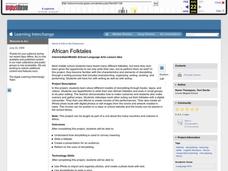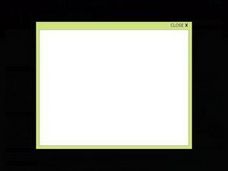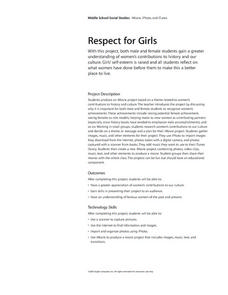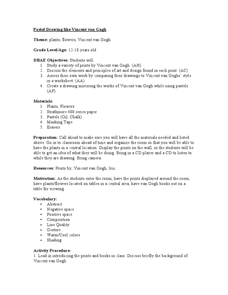Curated OER
African Folktales
Students examine the art of storytelling. In groups, they write their own African folktales, design costumes, props and scenery, and videotape folktale presented in dramatic form.
Curated OER
Data Analysis and Froot Loops
Use this probability and graphing lesson to have your learners work with a partner to make a necklace out of Froot Loops. They record the cereal colors randomly chosen and strung, graph their data, then use a ratio formula to determine...
Curated OER
Walk in My Shoes
Students discover how culture, geography and history affect how someone views an area of the world. They role play the role of a Palestinian, Jew or Briton and examine how they felt about Israel during its formation. To end the lesson,...
Curated OER
St. Patrick’s Day
Combine math, creative writing, and leprechauns in a fun St. Patrick's Day activity! Using a bag of gold coins and marshmallows, kids write a math story about a leprechaun that includes a multi-step equation to solve.
Curated OER
In Touch with Apples
Students read "How To Make an Apple Pie and See the World", the story of a girl who traveled the world to find the ingredients to make her apple pie. They conduct a series of interdisciplinary activities including testing their senses,...
Curated OER
Special Accommodations
This accommodations template provides a checklist of special accommodations that may be required for special needs learners in six areas: attention, academic, behavior, testing, speech/language, and OT/PT. Space is also provided for...
Curated OER
Respect for Girls
Students gain a greater appreciation of women's contributions to history and culture. They product an iMovie based on the contributions of women.
Curated OER
Pastel Drawing like Vincent Van Gogh
Learners discuss the elements of art and design found in a series of flower paintings by Vincent Van Gogh. They explore art, shading, and color as they create mirrored representations of the master's art, using oil pastel.
Curated OER
Exploration of "Pillbugs"
Fifth graders define vocabulary terms, identify the characteristics of a pillbug, and create a dichotomous key. Then they examine the pillbugs and make observations and record these observations. Finally, 5th graders observe specific...
Curated OER
Maus: After Reading Strategy Instructional Routine
Class members create literary mandalas for two characters from Maus, Art Spiegelman’s graphic novel about his father’s experiences with the Holocaust. After finding quotes that reveal three good traits and three bad traits of each...
Curated OER
On the Road with Marco Polo: Homecoming
Students role play as Marco Polo to detail his travels. They include the terrains, foods, religions, people and cultures that were encountered. They write a journal entry as if they were Marco Polo detailing one aspect of his travels.
Curated OER
Habitat Assessment
Third graders demonstrate the effects of varying environmental components on plants and animals: chemical, physical and biological characteristics of a habitat. They find chemical, physical and biological characteristics of the lake at...
Curated OER
What's In Your Bag?
Guess what is in the bag! Use this lesson at the beginning of the year to discuss appropriate items for 4th grade students to have in school. Each group develops a list of appropriate items as well as inappropriate items, and discusses...
Curated OER
Through the Eyes of the Big Bad Wolf
Imagine how the wolf would tell the tale of Little Red Riding Hood or The Three Little Pigs. Young writers re-imagine classic tales by adopting the point of view of another character in the story. After reading models like The True Story...
Curated OER
Latino Americans and Immigration Laws: Crossing the Border
Students identify both views on U.S. immigration policy. They write a persuasive essay defending either a liberal or restrictive immigration policy. Students identify the major laws regulating immigration since 1875. They create a...
Curated OER
Digging Up Dinosaurs
Students research dinosaurs using text, software, and Internet resources while role playing as paleontologists. They place the information from their research in databases and publish an illustrated page about their findings.
Curated OER
KWHL Questioning Strategy for Briar Rose
Whether new to the KWHL strategy or not readers of Briar Rose will benefit from the detailed procedures and templates designed for Jane Yolen’s novel. Links are provided for research into the Holocaust and activities reveal the many...
Curated OER
Bud, Not Buddy: List-Group-Label Vocabulary Strategy
Readers of Bud, Not Buddy demonstrate their knowledge of the Great Depression with a list, group, label vocabulary strategy. Included are complete directions for the activity that will also introduce class members to the new vocabulary...
Curated OER
Twelfth Night: The K-W-H-L Strategy
Readers of Twelfth Night use a KWHL chart to record information about what they know about Shakespeare's play, what they want to find out, how they plan on finding this information, and what they have learned or still want to learn about...
Curated OER
Arctic Animals: How Do They Measure Up?
Young scientists grab their measuring tapes, rulers, and yard sticks as they see how big Arctic animals really are. To conceptualize the trait of height or length, each small group will measure out the entire length of an arctic animal....
Curated OER
The Life of a Veteran
Students interview a veteran or he/her family to gather information about the person's life. They produce an iMovie that describes the veteran's military experience.
Curated OER
Sula/Song of Solomon/Tar Baby
Students answer assigned questions as a group, write individual essays, complete a research project, and complete a writing project.
Curated OER
Ocean Exploration: Shapes and Patterns Under the Sea
So many shapes in our vast oceans. Young explorers can discover new shapes in a variety of ways in this lesson. One way is having free exploration with a pattern shape kit handed out by the teacher. Another is by viewing a...
Curated OER
Operation Spaghetti
Find the math in recipes. Young chefs will follow a recipe and investigate the total cost for materials. They measure amounts of food necessary for the recipe and compute the per person cost.























